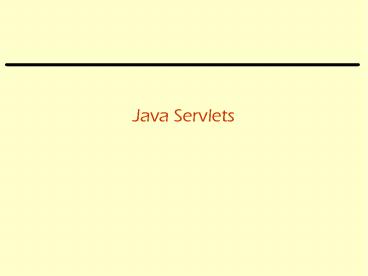Java Servlets - PowerPoint PPT Presentation
Title:
Java Servlets
Description:
Invoke it via new CGI shell process. Right way to use Java as CGI ... http://www.yahoo.com/search?music. Here, the text field contains music. ... – PowerPoint PPT presentation
Number of Views:87
Avg rating:3.0/5.0
Title: Java Servlets
1
Java Servlets
2
Basics
- What is Java Servlets?
- Javas solution to CGI programs.
- Wrong way to use Java as CGI
- Write stand-alone Java program
- Invoke it via new CGI shell process.
- Right way to use Java as CGI
- Use servlets and a servlet-compatible server.
3
How it works?
- Browser makes a servlet request to webserver.
- Webserver recognizes the URL as a servlet URL.
(e.g., http//www.obvious.com/servlets/blah) - Webserver loads servlet if not already loaded.
- Servlet executes and delivers output to webserver
(HTML output). - Webserver delivers output to Browser.
4
What you need to write servlets?
- Either JDK 1.1 and JSDK (Java Servlet Development
Kit). - JDK 1.2
- A servlet-compatible webserver.
5
GET POST
- When Form data is sent by the browser, it can be
sent in one of two ways (1) using the GET method
and (2) using the POST method. - In the GET method, the form data (parameters) is
appended to the URL, as in - http//www.yahoo.com/search?music
- Here, the text field contains music.
- In the POST method, the browser simply sends the
form data directly. - When you create an HTML form, you decide whether
you want to use GET or POST. - When you use GET, the doGet() method of your
servlet is called, otherwise the doPost() method
is called. - The standard practice is to use POST, unless you
need to use GET. - You need to use GET when you want a link to
invoke a CGI program (servlet).
6
Your first servlet -- Hello World
- import javax.servlet.
- import javax.servlet.http.
- import java.io.
- public class helloworld extends HttpServlet
- public void doGet (HttpServletRequest req,
HttpServletResponse resp) throws
ServletException, IOException - // Set the content type of the response.
- resp.setContentType ("text/html")
- // Create a PrintWriter to write the response.
- java.io.PrintWriter out new PrintWriter
(resp.getOutputStream()) - // The first part of the response.
- out.println ("") out.println ("") out.println
("") - // The greeting.
- out.println ("Yo, Hello World!")
- // Last part. out.println ("") out.println
("") out.close() - // Screen I/O
- System.out.println ("Inside servlet ... servlet
complete") - public void doPost (HttpServletRequest req,
HttpServletResponse resp) throws
ServletException, IOException doGet (req,
resp)
7
Hello World Notes
- The servlet class libraries need to be imported,
along with java.io.PrintWriter. - There are two methods, one for each type of
request GET or POST. - You can decide not to "really" implement one
method and instead have it call the other. - There are two object parameters to each method,
the "request" and the "respponse". - The HttpServletResponse instance has an
OutputStream that is used to write directly to
the requesting browser. - To make writing easier, we wrap a PrintWriter
around the OutputStream instance - // Create a PrintWriter to write the
response. - java.io.PrintWriter out new
PrintWriter (resp.getOutputStream()) - We set the content-type (as required by the HTTP
protocol) - // Set the content type of the
response. - resp.setContentType ("text/html")
- We write HTML to the output, e.g.,
- out.println ("")
- out.println ("")
- Don't forget to close the output stream
- out.close()
- Optionally, for debugging, we can also write to
the local screen where the webserver is running - System.out.println ("Inside servlet ...
servlet complete")
8
Extracting Parameters in a Servlet
- Idea -- create an HTML Form, and have a servlet
pick up the Form data entered by the user. - HTML Form
- lthtmlgt
- ltheadgtlttitlegtTest Postlt/titlegtlt/headgt
- ltbodygt
- ltform action"http//localhost8502/servlets/Tes
tform" method"post"gt Enter a string ltinput
type"text" name"param1"gt And then press "Go"
ltinput type"submit" value"Go"gt - lt/formgt
- lt/bodygt
- lt/htmlgt
9
Extracting Parameters in a Servlet
- Next the Java Servlet
- import javax.servlet.
- import javax.servlet.http.
- import java.io.
- import java.util.
- public class TestForm extends HttpServlet
- public void doPost (HttpServletRequest req,
HttpServletResponse resp) throws
ServletException, IOException - // Set the content type of the response.
- resp.setContentType ("text/html")
- // Create a PrintWriter to write the response.
- java.io.PrintWriter out new PrintWriter
(resp.getOutputStream()) // The first part of
the response. - out.println ("") out.println ("") out.println
("") - // Now get the parameters and output them back.
- out.println ("Request parameters ")
- Enumeration e req.getParameterNames()
- while (e.hasMoreElements())
- String name (String) e.nextElement()
- String value req.getParameter (name)
- if (value ! null) out.println (" name"
name " value" value "")
10
Notes for Extracting Parameters
- We need to import java.util.Enumeration. Whatever
parameters were provided are all in the
HttpServletRequest instance. We can list these
parameters by getting an Enumeration instance
from the request by calling getParameterNames() - Enumeration e req.getParameterNames()
- The "name" of a parameter is really the string in
the name attribute of the tag for the particular
Form element. For example, the name string is
param1 below. - Enter a string ltinput type"text"
name"param1"gt - Now, if we want to retrieve the actual string
typed in by the user, we use that name in
getParameter() - String whatTheUserTyped
req.getParameter - ("param1")































